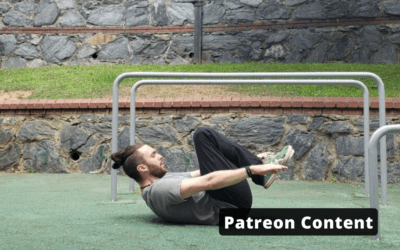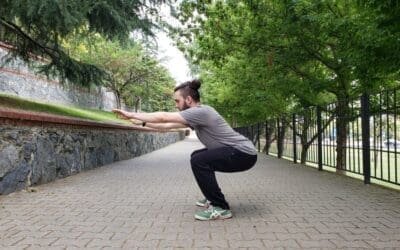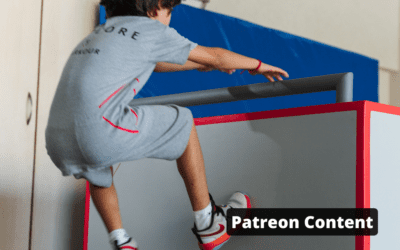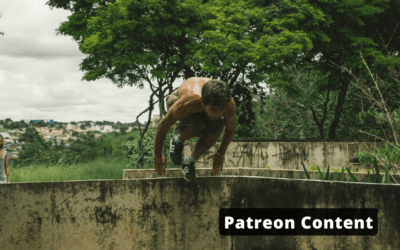
Where should I feel this Exercise?
Pecs, shoulders, triceps, scapulas, abs, and potentially glutes.
What’s the Main Purpose?
The push up is one of the first pushing exercises people will start with to build up their upper body pushing strength. For parkour this exercise can help build your wrists and shoulders(as well as the surrounding musculature) for some crawling variations, vaults and saving yourself in the event of a fall.
Tech Tips
Start with a variation that allows you to explore your full arms pushing ROM (fully bent to fully straight arms) and build up from there.
Secondly be sure to hold a slight hollow position with your torso so that you can work on building your familiarity with this position while pushing, since it will be useful for things like the cat crawl, cat pass, etc.
After you feel like you’ve progressed past a basic level of push up ability feel free to explore different positions, variations so that you can challenge yourself and continue building up your pushing ability.

Mobility Defecit (MD)
Scapula Push Up
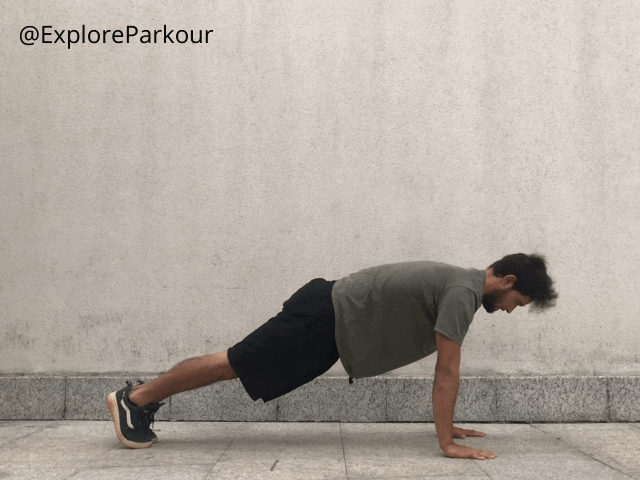
This movement is great for building awareness and strength in the shoulderblades and to begin preparing the surrounding muscles for movement. Healthy shoulders are necessary for all the swinging, crawling, climbing and vaulting we do.
Imagine pinching something hard in the middle of your back for the retraction portion and then trying to create as wide a back as you can between your shoulder blades for the protraction portion. If this movement is challenging you can try it in all fours position or even unweighted while sitting, standing etc. The goal is really to explore, understand and develop your ROM and control in your shoulder blades for self knowledge and as a prehab practice.
Strength Defecit (SD)
Positive Hand Placement
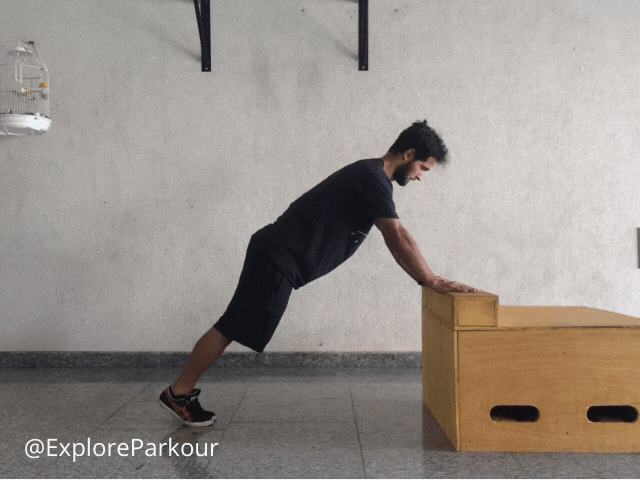
Putting your hands on an elevated surface pours more of your weight into your feet which will allow you to push yourself up and down more easily. This is a great progression for developing the ability to do a flat ground push up. Start at a height that takes some effort but still allows you to get full ROM without overarching your back or compensating in any other ways.
Be sure to keep your push up line at your sternum level to maintain the most similarities with the flat ground push up.
ISO - Push Up Hold

The Push Up Hold is great for building stability and tightness for crawls and vaults. This also acts as a precursor to more challenging holds. Learning to integrate tension between different parts of your body (arms and torso in this case.)
Focus on maintaining a hollow hold and whole body tension from your hands to your feet to get the most benefit of this exercise. It’s also a good exploration to work on maintaining the position in a relaxed way as well to not overtax the muscles for more of mental focus challenge. Don’t forget to maintain a comfortable breathing pattern for this exercise (and most of the others too.)
Push Up Negative

As an alternative to building up to the flat ground push up just focusing on a negative is a classic progressive tactic that can be applied to most exercises.
Use this to build the control in your descent and build the muscles up to help make the flat ground PU more attainable. This can be combined with most any push up variation to make it more accessible if desired.
Knees Support
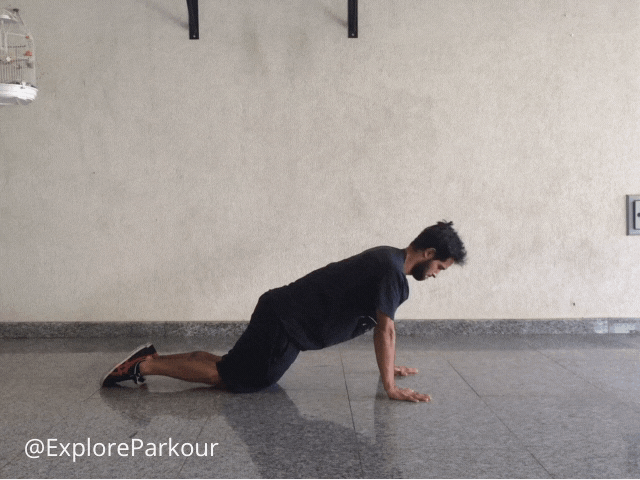
This is another classic push up progression movement. It’s not my personal favorite as it tends to make the hollow hold a bit tougher and changes the balance a bit from the flat ground push up movement.
That being said explore this movement and if it helps you in your journey to a flat ground push up more power to you. When completing it be sure to initiate a hollow before you start the movement and aim your push up to touch the ground near your sternum.

Environmental
Depth Push up

This variation allows you to get a way deeper range of motion since your body can move beyond where your hand/foot placement is.
Play with this to get more pec and bicep development. The P-Bar push up can also be useful for some descending and ascending climbing movements.
Restriction
Single Arm Push Up

Same push up taste with half the limb usage! This variation is great if you want something harder than the normal push up and the asymmetry of the movement is useful for how your arms absorb into a roll as well as some climbing/crawling variations.
Play with the negative of this while you learn it as well as explore with letting your torso twist or fighting the twist (distance between your legs can affect this too) to see how you can let more of your body do the movement vs focus the force on the pushing arm. By exploring the different initiators of effort for this movement you can find the balance that fits for your purposes.
Path of Travel
Falling Push up

This movement can help develop wrist integrity (once you are strong enough for it) for some vaults and crawling (like the monkey crawl, catpass, cast push, etc.) and for lower impact falls you can use this to save yourself or regain balance.
Be careful so your chin/face doesn’t hit the floor when you try this move, start with reaching for smaller distances and then slowly increasing the distance. Aim to absorb the force of your fall towards your chest so you can good involvement of your pecs, shoulders, biceps, and triceps.
Diving Monkey Push up

Can help at the basic level with climb ups, muscle ups and general pushing strength for crawling movements (like the grasshopper, seal, etc.).
Don’t worry about having straight legs in this movement if your hamstring and calf mobility isn’t there yet, just do your best throughout the movement. Make sure you’re not compensating for your abs by relaxing your back, your torso should be engaged the whole time, even during the arching portion. You can do this movement in parts with rests in between until you build up the strength to do it all together.
Tempo
Plyometric Push Up

This variation helps to prepare the wrists, shoulders, elbows and associated muscles for higher impact movements, similar to the falling push up.
Keep good ROM, try and keep a neutral wrist position when doing this on elevated surfaces so you don’t fatigue the wrists unecessarily. Be sure to use your scapula and fingers at the end of the push so you can learn to use them in techniques.
Slow Motion Push Up

Slowing down a technique is good for testing that you are able to keep your muscles activated throughout the entirety of the movement. For Parkour that is important since your body may be required to absorb or generate force at any time and in any given part of your ROM. Secondly it’s safer than a more explosive movement if the movement pattern is newer for your body.
Move slowly to see any sticking points or weaknesses so that you can do some accessory rehab/prehab if necessary.
Try slowing down your push up as a nice warm up and/or test to see how well your body is able to control this movement pattern.
Body Position
Diamond Push Up

The diamond push up offers slightly more tricep involvement than the general push up and can require a little bit more of a balance challenge as well.
This can potentially help build up to the linear balance push up, or the pushing technique that can be used in shoulder rolls as well.
Handstand Push Up

This is a great benchmark to showcase, test and develop overhead pushing strength with just your body.
In Parkour any kind of inverted pushing techniques can benefit from the strength that also requires a HSPU such as cartwheels, round offs, press springs, catpass fronts, double kongs, etc. all fit into this mold for example.
Play with partial reps, negatives, elevated feet, kipping and/or using ledges to help build up the strength to do a full HSPU.
Front Dip

The dip is a great benchmark for pushing down and the front dip is an exercise that we also use a lot when we climb or swing up/down from things. This movement is also useful for specific movements like cast backs, cast pushes, climb ups, etc.
Generally you can try this on a wall or bar, think about pushing the hips back and away as you aim your sternum with control towards whatever you are dipping on. This will keep you from scraping yourself and making the friction of your body against the surface less of an obstacle during this movement.
Russian Push Up

This movement can act as a piece of the diving monkey push up and follows the same general pattern as the climb up as well (albeit with different pushing, balance and muscular involvement).
Play with this technique to help prepare the elbows for the movements above while also seeing how it feels to push and transfer from forearms to elbows and vice versa. Control the transitions (rather than letting gravity do the work) in this movement to get the most muscular involvement.
Combination
Linear Balance Push up

This shares some muscular involvement with the diamond push up but ups the difficulty a lot by requiring your entire body to balance during the entirety of it.
As you can imagine this is useful for balancing and crawling movements like cat crawl balance. The stability required to complete this movement will likely require more involvement of your CNS, similar to the difference between machine vs free weight exercise.
Burpee

This movement is a great progression for cat passes/the monkey crawl since it shares a similar hip hinge, tuck and push up pattern.
You can use this as a straight to the point warm up for relevant techniques. Keep your abs a bit engaged on the pushing up portion of this movement so that you can get a nice transition of momentum from the hips snapping up into the push/tuck part of the movement.
Cat Crawl Push Up
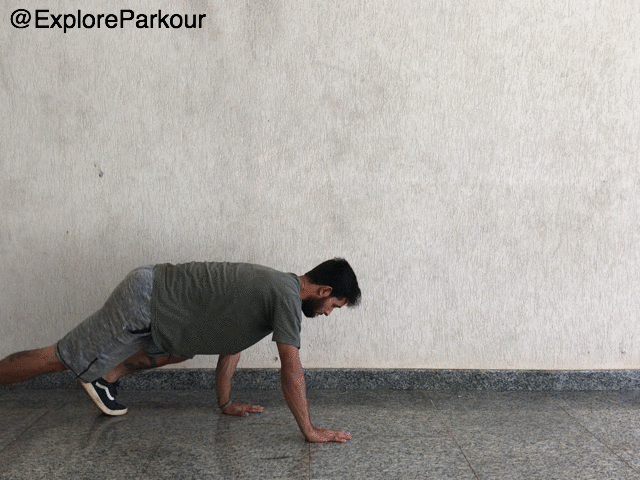
Known also as the alligator crawl and probably other stuff too, this is a nice addition to your cat crawling movements if you want to work on more bent arm pushing positions in your training.
Things like the QDR, bent arm cartwheel and low down crawling movements can be improved by building strength with this move. You can modulate how much of your weight is on your arms or legs to change how this movement fatigues your body. Explore and enjoy!
Extra Weight
Resistance Push Up

A classic way to make a movement more difficult is just to add more weight. So take the push up, add a light or not so light friend to increase the difficulty and potentially the strength benefit! You can also play with accommodating resistance with this method if you are using a friend to help you instead of just adding dead weight to yourself.
Make sure you can complete the base movement unweighted (and with lighter weights) safely before venturing into adding extra weight. Just like adding speed to a movement, when you increase the weight there is more risk of injury so be careful when you play with his modifier.
Related Exercises
Tuck Up
Where should I feel this Exercise? Abs and hip flexors predominantly. Can also use the shoulders and pecs a bit for the arm movement. What’s the Main Purpose? Helps develop power for jumps, flips and other movements (like the cat pass) that require an explosive...
Squat
Where should I feel this Exercise? Quads, Hamstrings, Glutes, and slight tension in your abs are the goals here. What’s the Main Purpose? The squat is great for understanding body alignment with your back and knees for the more high impact movements in Parkour. It...
Related Techniques
Cat Leap
Also known as: Cat, Arm Jump, Cat JumpMovement Pieces The basic sequence of micro-transitions in this move is… - Like a Precision Jump, start with your toes at the edge of the obstacle. Squat - close to 1/3 - and bring your arms down and back as you lean forward -...
Dyno
Movement PiecesThe basic sequence of micro-transitions in this move is… - Start from a Cat Hang position on a wall high enough so your legs can be in a comfortable staggered position. The upper foot will be at least waist height and is used to support and push you...
Cat Pass
Also known as: Kong, Monkey Vault or Saut de Chat.Movement PiecesThe basic sequence of micro-transitions in this move is… - Choose a stable obstacle close to your hip height, with short width and enough space to place your hands on the top. - Give yourself enough...

